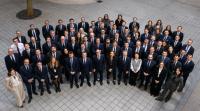
Chinese President Xi Jinping, leader of the world’s largest CO2 emitter, is conspicuous by his absence at the COP26 climate summit in Glasgow. Critics consider the ‘unclear’ Chinese climate policy the nail in the coffin of the Paris Agreement.
For many investors, the policy is too foggy too, “but that is unjustified”, said Arnout van Rijn, CIO Asia Pacific at Robeco, in an interview with Fondsnieuws, Investment Officer Luxembourg’s Dutch-language sister publication. According to him, there is no reason to play down China’s climate ambitions.
China became the world’s largest emitter of carbon dioxide in 2006 and is now estimated to be responsible for a quarter of the world’s total greenhouse gas emissions. In 2020, Chinese President Xi Jinping said his country would aim to reach peak emissions by 2030 and achieve carbon neutrality by 2060.
Although this statement has now been confirmed as China’s official position ahead of the global climate summit COP26 in Glasgow, critics say the Chinese government has not specified exactly how these goals will be achieved. But according to van Rijn, besides being incorrect, this is no reason to write China off as unsustainable.
“The West can still learn a lot from the track record of the Chinese when it comes to achieving set targets. I also see realistic, achievable plans for the country’s climate policy. The goals the western world has set itself for 2050 are, in my opinion, merely ambitions”, said van Rijn.
A copy-paste strategy
“It is absolutely not the case that China is not concerned about the climate. A very concrete plan has been shared about what the energy mix should look like in 2050.” 85 per cent of the energy used is now fossil, and that is now being reduced to 25 per cent. China is also working on achieving energy independence and, partly for that reason, will also focus on sustainable energy.
Van Rijn explained: “The country is sailing its own course because it has a totally different conviction about how a nation should be developed. This conviction may be in stark contrast to what Western democracies would like to see, but they would rather see wealth development than a high position on Maslow’s pyramid.”
According to van Rijn, China will maintain a “copy-paste strategy” with which it has been demonstrably successful in the past. According to him, technology aimed at reducing climate change is being developed at a rapid pace. “Think of battery technology and energy storage technology. In time, that technology will also be exported in the region. They have now found the recipe to develop it quickly and efficiently. They will only expand on that in the years to come, it’s as simple as that, as far as I’m concerned.”
ESG in China is no easy task
Van Rijn acknowledges that more stringent European regulations regarding unsustainable investments could pose a problem for investors with exposure to China. “Robeco has an ESG engagement strategy, but as soon as it comes to human rights, you’re talking to a wall in many cases,” said the CIO. “A lot is culturally determined in Asian companies, which is a struggle. A number of our social goals are very difficult to discuss.”
According to van Rijn, commitment in the area of the environment, on the other hand, is relatively easy. “We see real commitment and dedication on the part of Chinese companies to make adjustments. They just do not have the ambition to convince the whole world of their plans.”
Normal monetary policy
Another major advantage that continues to make China attractive to investors is its “normal” monetary policy, according to van Rijn. With an interest rate of 3 percent and relatively low inflation, there is even positive real interest, which is unique in the current global economy. Also, the negative correlation of Asian markets with dollar interest rates is getting weaker, said van Rijn. “Investors looking for yield used to take money out of emerging markets when dollar interest rates were rising, but we see less and less of that.”
Van Rijn acknowledged the risks created by the strong debt growth since 2008. “Now they are putting a brake on it. The signal fire has not yet been given, but China is definitely aware of the risks. In the West there is a lot of talk and many things are pushed forward, but in China they act much faster.”
Chinese ESG funds attractive but volatile
Morningstar expects increasing investment in the long-term growth of sectors related to decarbonising China’s economy, such as electric vehicles and renewable energy. China saw a sharp increase in net inflows of money into sustainability funds (USD 5.3 billion) in the fourth quarter of last year, up from USD 966 million in the third quarter.
Nevertheless, the growth of ESG funds in China has slowed dramatically since then. Net inflows into ESG funds in China fell to just under USD 500 million in the first quarter of 2021, according to Morningstar. However, this dip in sentiment turned into a sell-off in the second quarter, when SRI funds in China experienced net outflows of $374 million.















